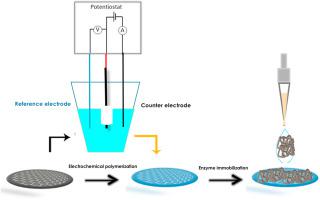当前位置:
X-MOL 学术
›
Mater. Chem. Phys.
›
论文详情
Our official English website, www.x-mol.net, welcomes your feedback! (Note: you will need to create a separate account there.)
Indenoquinoxalinone based conjugated polymer substrate for laccase biosensor
Materials Chemistry and Physics ( IF 4.6 ) Pub Date : 2021-01-01 , DOI: 10.1016/j.matchemphys.2020.123788 Şevki Can Cevher , Sıddıka Aybüke Bekmezci , SaniyeSoylemez , Yasemin Arslan Udum , Levent Toppare , Ali Çırpan
Materials Chemistry and Physics ( IF 4.6 ) Pub Date : 2021-01-01 , DOI: 10.1016/j.matchemphys.2020.123788 Şevki Can Cevher , Sıddıka Aybüke Bekmezci , SaniyeSoylemez , Yasemin Arslan Udum , Levent Toppare , Ali Çırpan

|
Abstract This paper describes the synthesis and characterization of a novel monomer (6,9-bis(4-hexylthiophen-2-yl)-11H-indeno[2,1-b]quinoxalin-11-one (M1)). M1 monomer was electrochemically polymerized on the electrode surface and used as a sensing platform for the immobilization of laccase. Moreover, electrochemical and optical properties of the corresponding polymer were performed in detail. To the best of our knowledge, electrochemical and biosensor performance of the polymer were investigated for the first time. The PM1/Laccase were used in the fabrication of a new biosensor for determination of catechol in water samples by amperometric methods. Under optimized conditions, the calibration curve showed a linear range of 0.005–0.175 mM, with a limit of detection of 9.86 μM and high sensitivity of 153.6 μA/mMcm2. The biosensor exhibited good stability, selectivity and high sensitivity toward catechol.
中文翻译:

用于漆酶生物传感器的茚并喹喔啉酮基共轭聚合物基质
摘要 本文描述了一种新型单体(6,9-双(4-己基噻吩-2-基)-11H-茚并[2,1-b]喹喔啉-11-酮(M1))的合成和表征。M1单体在电极表面进行电化学聚合,用作固定漆酶的传感平台。此外,详细地进行了相应聚合物的电化学和光学性能。据我们所知,聚合物的电化学和生物传感器性能是第一次研究。PM1/漆酶用于制造一种新的生物传感器,用于通过安培法测定水样中的儿茶酚。在优化条件下,校准曲线的线性范围为 0.005–0.175 mM,检测限为 9.86 μM,灵敏度为 153.6 μA/mMcm2。
更新日期:2021-01-01
中文翻译:

用于漆酶生物传感器的茚并喹喔啉酮基共轭聚合物基质
摘要 本文描述了一种新型单体(6,9-双(4-己基噻吩-2-基)-11H-茚并[2,1-b]喹喔啉-11-酮(M1))的合成和表征。M1单体在电极表面进行电化学聚合,用作固定漆酶的传感平台。此外,详细地进行了相应聚合物的电化学和光学性能。据我们所知,聚合物的电化学和生物传感器性能是第一次研究。PM1/漆酶用于制造一种新的生物传感器,用于通过安培法测定水样中的儿茶酚。在优化条件下,校准曲线的线性范围为 0.005–0.175 mM,检测限为 9.86 μM,灵敏度为 153.6 μA/mMcm2。



























 京公网安备 11010802027423号
京公网安备 11010802027423号